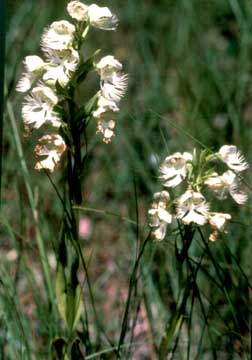PDF Version

photo
by Marlin Bowles
Eastern Prairie Fringed Orchid |

photo
by Marlin Bowles
Western Prairie Fringed Orchid
|
The
eastern and western prairie fringed orchids are threatened species.
Threatened species are animals and plants that are likely to become
endangered in the foreseeable future. Endangered species are animals and plants that are in danger of becoming extinct. Identifying,
protecting, and restoring endangered and threatened species is the
primary objective of the
Fish and Wildlife Service's
endangered species program.
What are prairie fringed orchids?
- Scientific
Name - Platanthera leucophaea (eastern prairie fringed orchid); Platanthera praeclara (western prairie fringed orchid)
- Appearance - Both
orchids produce flower stalks up to 47 inches tall. Each stalk has
up to 40 white flowers about an inch long. The western prairie fringed
orchid's flowers are somewhat larger than those of the closely related
eastern prairie fringed orchid.
- Range - The eastern prairie fringed orchid occurs mostly east of the Mississippi
River in fewer than 60 sites in Illinois, Iowa, Maine, Michigan,
Ohio, Virginia, Wisconsin, and in Ontario, Canada. The western prairie
fringed orchid is restricted to west of the Mississippi River and
currently occurs in Iowa, Kansas, Minnesota, Nebraska, North Dakota,
and in Manitoba, Canada.
- Habitat - Both orchids occur most often in mesic to wet unplowed tallgrass
prairies and meadows but have been found in old fields and roadside
ditches. The eastern prairie fringed orchid also occurs in bogs,
fens, and sedge meadows. Reproduction - The nocturnally fragrant
flowers of these perennial orchids attract hawkmoths that feed on
nectar and transfer pollen from flower to flower and plant to plant.
Seed germination and proper plant growth depend on a symbiotic relationship
between the plants' reduced root systems and a soil-inhabiting fungus
for proper water uptake and nutrition.
Why are the
Prairie Fringed Orchids Threatened
- Habitat
Loss or Degradation - The greatest threat to the prairie fringed orchids is habitat
loss, mostly through conversion to cropland. Competition with introduced
alien plants, filling of wetlands, intensive hay mowing, fire suppression,
and overgrazing also threatens these species
- Collection - These orchids have
been collected because of their rarity and beauty.
- Pesticides and Other Pollutants - The prairie fringed
orchids depend on hawkmoths for pollination.
Any threat to these insects, such as the use of insecticides, is
a threat to the prairie fringed orchids.
What
is Being Done to Prevent Extinction of the Prairie Fringed Orchids?
- Listing - The prairie fringed
orchids were added to the U.S. List of Endangered and Threatened
Wildlife and Plants on September 28, 1989.
- Recovery
Plan - The
U.S. Fish and Wildlife Service is developing recovery plans that
describes actions needed to help this plant survive. The Service
approved the recovery plan for western prairie fringed orchid in
1996.
- Research - Researchers are studying
the prairie fringed orchids to find the best ways to manage for
the orchids and their habitat.
- Habitat
Protection - Where possible, the
orchids' habitat is being protected and habitat is improved with
a variety of management techniques. In Illinois, seed was dispersed
on some public lands that had good habitat but no orchids. Subsequently,
orchids bloomed on at least one of those sites. Private landowners,
government agencies, and conservation organizations are helping
conserve these species.
- Public Education - Public education programs
have been developed to raise awareness of the orchids' plight.
What
Can I Do to Help Prevent the Extinction of Species?
- Learn - Learn more about prairie
fringed orchids and other endangered and threatened species. Understand
how the destruction of habitat leads to loss of endangered and threatened
species and our nation's plant and animal diversity. Tell others
about what you have learned.
- Write - Write to elected officials
in your local, state, and national government to voice your support
for conservation of threatened and endangered species.
- Join - Join a conservation
group; many have local chapters.
Fact Sheet created 12/2004
Back to Plants page






